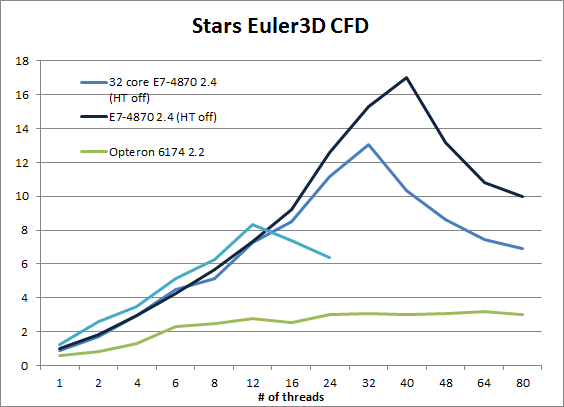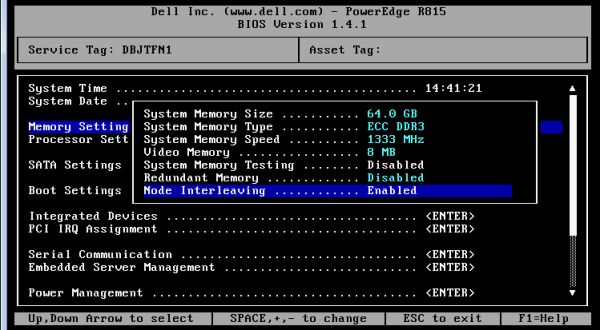Rendering and HPC Benchmark Session Using Our Best Servers
by Johan De Gelas on September 30, 2011 12:00 AM ESTInvestigating the Opteron Performance Mystery
What really surprised us was the Opteron's abysmal performance in Stars Euler3D CFD. We did not believe the results and repeated the benchmark at least 10 times on the quad Opteron system. Let us delve a little deeper.

Notice that the Intel Xeons scale very well until the number of threads is higher than the physical core count. The performance of the 40 core E7-4870 only drops when we use 48 threads (with HT off). The Opteron however only scales reasonably well from 1 to 6 threads. Between 6 and 12 threads scaling is very mediocre, but at least performance increases. From there, the performance curve is essentially flat.
The Opteron Performance Remedy?
We contacted Charles of Caselab with our results. He gaves us a few clues:
1. The Euler3d CFD solver uses an unstructured grid (spider web appearance with fluid states stored at segment endpoints). Thus, adjacent physical locations do not (cannot!) map to adjacent memory locations.
2. The memory performance benchmark relevant to Euler3D appears to be the random memory recall rate and NOT the adjacent-memory-sweep bandwidth.
3. Typical memory tests (e.g. Stream) are sequential "block'' based. Euler3D effectively tests random access memory performance.
So sequential bandwidth is not the answer. In fact, in most "Streamish" benchmarks (including our own compiled binaries), the Quad Opteron was close to 100GB/s while the Quad Xeon E7 got only between 37 and 55GB/s. So far it seems that only the Intel compiled stream binaries are able to achieve more than 55GB/s. So we have a piece of FP intensive software that performs a lot of random memory accesses.
On the Opteron, performance starts to slow down when we use more than 12 threads. With 24 or even better 48 threads the application spawns more threads than the available cores within the local socket. This means that remote memory accesses cannot be avoided. Could it be that the performance is completely limited by the threads that have to go the furthest (2 hops)? In others words, some threads working on local memory finish much faster, but the whole test cannot complete until the slowest threads (working on remote memory) finish.
We decided to enable "Node Interleaving" in the BIOS of our Dell R815. This means that data is striped across all four memory controllers. Interleaved accesses are slower than local-only accesses because three out of four operations traverse the HT link. However, all threads should now experience a latency that is more or less the same. We prevent the the worst-case scenario where few threads are seeing 2-hop latency. Let us see if that helped.











52 Comments
View All Comments
mino - Saturday, October 1, 2011 - link
Memory channel count has nothing to do with coherency traffic.mino - Saturday, October 1, 2011 - link
Exactly. Actually the optimized way would normally be to split the workload into 12-thread chunks on Opterons and 20-thread chunks on Xeons. That is also a reason why 4S machines rarely seen in HPC.They just do not make sense for 99% of the workloads there.
lelliott73181 - Friday, September 30, 2011 - link
For those of us out there that are seriously into doing distributed computing projects, it'd be cool to see a bit of information on how these systems scale in terms of programs like BOINC, Folding@home, etc.MrSpadge - Friday, September 30, 2011 - link
Scaling is pretty much perfect there, not very interesting. It may have been different back in the days when these big iron systems were starved for memory bandwidth.MrS
fic2 - Friday, September 30, 2011 - link
Was hoping for some Bulldozer server benchmarks since the server chips are "released". ;o)Didn't really think that I would see them though.
rahvin - Friday, September 30, 2011 - link
Have you considered that the Opteron problem could because the software is compiled with the Intel compiler which is disabling advanced features if it doesn't detect an Intel processor? This is a common problem in that the ICC compiler sets flags that if the processor doesn't find an Intel processor it turns off SSE and all the processor extensions and runs the code in x86 compatibility mode (very slow). Any time I see results that drastically off it reads to me that the software in question is using the Intel complier.Chibimyk - Friday, September 30, 2011 - link
Ifort 10 is from 2007 and is not aware of the architectures of any of these machines. It doesn't support the latest sse instructions and likely doesn't know the levels of sse supported by the cpus. You have no idea which math libraries it is linked to. It won't be using the latest Intel MKL which supports the newest chips. It isn't using the AMD optimized ACML libraries either.What you are comparing using these compiled binaries is the performance of both systems when running intel optimized code.
You also have no idea of the levels of optimization used when compiling. Some of the highest optimization speed increases with the Intel compilers drop ANSI accuracy, or at least used to. Whether this impacts results is application specific.
Generally speaking:
Intel chips are fastest with Intel compilers and Intel MKL.
AMD chips are fastest with the Portland Group compilers and AMD ACML.
Some code runs faster with the Goto BLAS libraries.
Ideally you want to compare benchmarks with each system under ideal conditions.
eachus - Saturday, October 1, 2011 - link
Definitely true about AMD chips and the Portland Group. I get slightly better results with GCC than the Intel compiler, partly because I know how to get it to do what I want. ;-) But Portland is still better for Fortran.Second, there is a way to solve the NUMA problem that all HPC programmers know. Any (relatively static) data should be replicated to all processors. Arrays that will be written to by multiple threads can be duplicated with a "fire and forget" strategy, assuming that only one processor is writing to a particular element (well cache line)* in the array between checkpoints. In this particular case, you would use (all that extra) memory to have eight copies of the (frequently modified) data.
Next, if your compiler doesn't use non-temporal memory references for random access floating-point data, you are going to get clobbered just like in the benchmark. (I'm fairly sure that the Portland Group compilers use PrefetchNTA instructions by default. I tend to do my innermost loops by hand on the GCC back end, which is how I get such good results. You can too--but you really need to understand the compiler internals to write--and use--your own intrinsic routines.) What PrefetchNTA does is two things, first
it prefetches the data if it is not already in a local cache. This can be a big win. What kills you with Opteron NUMA fetches is not the Hypertransport bandwidth getting clogged, it is the latency. AMD CPUs hate memory latency. ;-)
The other thing that PrefetchNTA does is to tell the caches not to cache this data. This prevents cache pollution, especially in the L1 data cache. Oh, and don't forget to use PrefetchNTA before writing to part of a cache line. This is where you can really get hit. The processor has to keep the data to be stored around until the cache line is in a local cache. (Or in the magic zeroth level cache AMD keeps in the floating point register file.) Running out of space in the register file can stall the floating point unit when no more registers are available for renaming purposes.
Oh, and one of those "interesting" features of Bulldozer for compiler gurus is that it strongly prefers to have only one NT write stream at a time. (Reading from multiple data streams is apparently not an issue.) Just another reason we have to teach programmers to cache line aligned records for data, rather than many different arrays with the same dimensions. ;-)
* This is another of those multi-processor gotchas that eats up address space--but there is plenty to go around now that everyone is using 64-bit (actually 48-bit) addresses. You really don't want code on two different CPU chips writing to the same cache line at about the same time, even if the memory hardware can (and will) go to extremes to make it work.
It used to be that AMD CPUs used 64-byte cache lines and Intel always used 256-byte lines. When the hardware engineers got together for I think the DDR memory standard, they found that AMD fetched the "partner" 64 byte line if there were no other request waiting, and Intel cut fetches at 128 bytes if there was a waiting memory request. So it turned out that the width of the cache line inside the CPUs were different, but in practice most of the main memory accesses were 128-bytes wide no matter whose CPU you had. ;-) Anyway a data point for fluid flow software tends to have 48 bytes or so per data point. (Six DP values x,y, and z, and x',y' and z'. Aligning to 64-byte boundaries is good, 128-bytes is better, and you may want to try 256-bytes on some Intel hardware...)
mino - Saturday, October 1, 2011 - link
You deserve the paycheck for this article!Howgh.
UrQuan3 - Monday, October 3, 2011 - link
I'd like to add one to the request for a compiler benchmark. It might go well with the HPC study. The hardest part would, of course, be finding an unbiased way to conduct it. There's just so many compiler flags that add their own variables. Then you need source code.If you do decide to give it a try, Visual Studio, GCC, Intel, and Portland would be a must. I don't know how Anandtech would do it, but I've been impressed before.